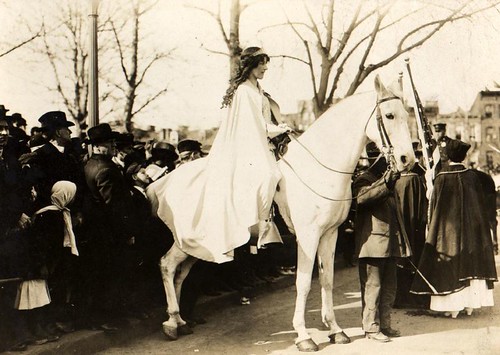
"I am prepared to sacrifice every so-called privilege I possess in order to have a few rights."
Inez Milholland, 1909
March is here and that means it’s time to celebrate the incredible women who have shaped our lives and made the everyday experience a better place for all. This year the NEHP theme is, Our History is Our Strength. “This theme pays tribute to the millions of women who have taken action to help create a better world for the times in which they lived, as well as for future generations. In keeping with this years theme I would like to review the life and work of Inez Milholland (Boissevain) an American suffrage, early feminist and activist for the disenfranchised.
Known as the poster or face for the suffrage movement she is best known for donning a white hose, draped in a long white flowing cape, leading a major demonstration right down the center of Pennsylvania Avenue to secure the women’s right to vote. “On Monday, March 3, 1913, lawyer Inez Milholland Boissevain, clad in a white cape and riding a white horse, led the great women's suffrage parade down Pennsylvania Avenue in the nation's capital. Behind her stretched a long procession, including nine bands, four mounted brigades, three heralds, more than 20 floats and more than 5,000 marchers. Women from countries that had enfranchised women held the place of honor in the first section of the procession. Then came the "pioneers" who had struggled for so many decades to secure women's right to vote. The next sections celebrated working women, who were grouped by occupation and wore appropriate garb -- nurses in uniform, woman farmers, homemakers, woman doctors and pharmacists, actresses, librarians -- Harriet Hifton of the Library of Congress's Copyright Division led the librarians' contingent -- and college women in academic gowns. Next came the state delegations and, finally, the separate section for male supporters of woman suffrage. According to the official program of the suffrage procession, all had come from around the country "to march in a spirit of protest against the present political organization of society, from which women are excluded.” (Harvey S, Library of Congress)
Involved in a great many projects Milholland worked tirelessly not only for women but all Americans marginalized by circumstance and place. A charismatic speaker she was said to electrify crowds. By 1916 she was a popular figurehead and speaker for the National American Woman Suffrage Association. While giving a speech in Los Angeles, Inez Milholland collapsed was hospitalized and died 10 weeks later from pernicious anemia. Her death sent shock waves through the movement and she became a martyr for the cause. Alice Paul organized Milholland's memorial service, which was held in Statuary Hall in the U.S. Capitol building on Christmas Day, 1916.
Known as the poster or face for the suffrage movement she is best known for donning a white hose, draped in a long white flowing cape, leading a major demonstration right down the center of Pennsylvania Avenue to secure the women’s right to vote. “On Monday, March 3, 1913, lawyer Inez Milholland Boissevain, clad in a white cape and riding a white horse, led the great women's suffrage parade down Pennsylvania Avenue in the nation's capital. Behind her stretched a long procession, including nine bands, four mounted brigades, three heralds, more than 20 floats and more than 5,000 marchers. Women from countries that had enfranchised women held the place of honor in the first section of the procession. Then came the "pioneers" who had struggled for so many decades to secure women's right to vote. The next sections celebrated working women, who were grouped by occupation and wore appropriate garb -- nurses in uniform, woman farmers, homemakers, woman doctors and pharmacists, actresses, librarians -- Harriet Hifton of the Library of Congress's Copyright Division led the librarians' contingent -- and college women in academic gowns. Next came the state delegations and, finally, the separate section for male supporters of woman suffrage. According to the official program of the suffrage procession, all had come from around the country "to march in a spirit of protest against the present political organization of society, from which women are excluded.” (Harvey S, Library of Congress)
Involved in a great many projects Milholland worked tirelessly not only for women but all Americans marginalized by circumstance and place. A charismatic speaker she was said to electrify crowds. By 1916 she was a popular figurehead and speaker for the National American Woman Suffrage Association. While giving a speech in Los Angeles, Inez Milholland collapsed was hospitalized and died 10 weeks later from pernicious anemia. Her death sent shock waves through the movement and she became a martyr for the cause. Alice Paul organized Milholland's memorial service, which was held in Statuary Hall in the U.S. Capitol building on Christmas Day, 1916.
Iron Jawed Angels, a movie released to critical acclaim is a portrayal of Millholland and the suffrage struggle.
So shine on sisters, shine on!
No comments:
Post a Comment